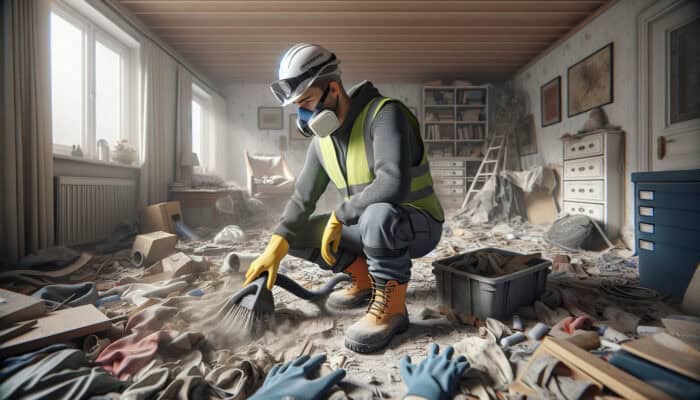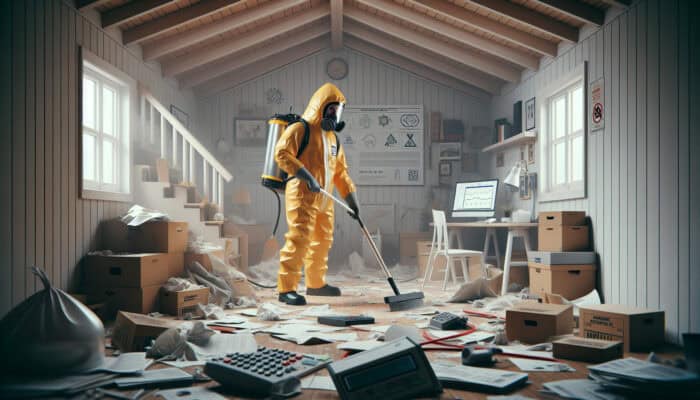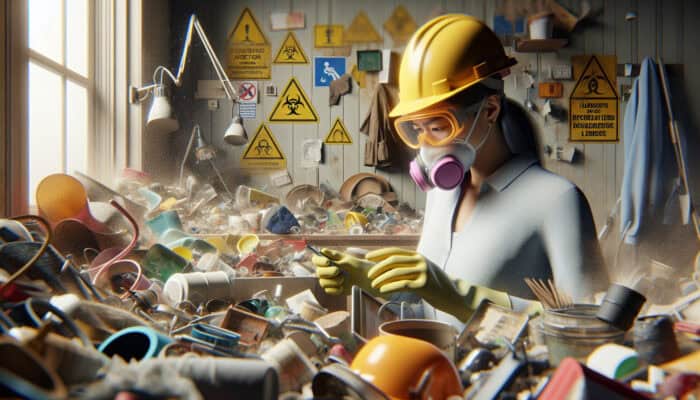Recognising the Essential Role of Protective Gear in Safeguarding House Clearance Operations Across the UK
Essential Protective Gear Needed for Effective House Clearance Projects

When undertaking house clearance operations throughout the UK, the importance of employing appropriate protective gear tailored for safe house clearance tasks cannot be overstated. These operations often expose workers to numerous hazards that can compromise their safety and well-being, making it imperative to equip them with the necessary protective equipment. The essential items required for ensuring safety during these tasks include:
- Safety Gloves: These are crucial for preventing cuts and abrasions, significantly reducing the risk of injury while handling various materials encountered during clearance operations.
- Face Masks: Essential for filtering out dust and allergens that could adversely impact respiratory health.
- Safety Boots: Specifically designed to protect feet from heavy items and sharp objects that may be present during clearance tasks.
- Protective Goggles: Vital for safeguarding the eyes from debris and harmful substances that may exist in the work environment.
- High-Visibility Clothing: Ensures that workers remain easily identifiable in potentially hazardous settings, thereby reducing the risk of accidents.
- Hard Hats: Crucial for protection against falling objects, particularly in areas undergoing demolition or construction.
- Ear Protection: Necessary in noisy environments to prevent hearing loss.
- Respirators: Indispensable when working with hazardous chemicals or mould, preventing the inhalation of dangerous particles.
Grasping the necessity of these items is vital for establishing a comprehensive safety protocol in house clearance jobs, ensuring that workers can perform their duties with confidence while minimising the risk of injury or exposure to hazardous conditions. By prioritising the use of protective gear, employers can create a safer and more efficient working environment for their teams.
Examining the Progression of Protective Gear Development in the UK
The development of protective gear in the UK has undergone significant transformation, driven by advancements in materials science and an increased awareness of occupational health and safety. Historically, workers relied on basic gear that was often handmade and lacked proper standardisation. However, the industrial revolution, coupled with a rise in workplace accidents, prompted regulatory bodies to enforce stricter safety protocols, fundamentally changing the landscape of protective gear.
Technological advancements have led to the creation of materials that are lighter, more durable, and more comfortable for extended wear. For instance, the introduction of breathable fabrics in safety clothing has considerably improved worker comfort, enabling prolonged use without discomfort. Furthermore, innovations in impact-resistant and slip-resistant technologies in footwear have significantly reduced the incidence of injuries in the workplace, showcasing the importance of ongoing development in protective gear.
The regulatory framework has evolved as well, exemplified by regulations such as the Health and Safety at Work Act 1974, which outlines explicit requirements for protective equipment. This progression has motivated manufacturers to produce gear that not only meets regulatory standards but also anticipates the needs of workers, thereby enhancing their safety and comfort during various house clearance tasks.
The Crucial Importance of Adhering to UK Safety Regulations
Adhering to UK health and safety regulations is essential for safeguarding the well-being of individuals engaged in house clearance operations. The UK government has established a comprehensive framework aimed at protecting workers, which includes the provision and proper utilisation of protective gear. Compliance with these regulations not only ensures the safety of employees but also protects employers from potential liabilities arising from workplace accidents, thus fostering a culture of responsibility within the workforce.
Failing to comply with safety regulations can result in severe consequences, including hefty fines and potential imprisonment. However, the primary concern remains the protection of the workforce. The inherent risks associated with house clearance tasks, such as exposure to hazardous materials and the potential for physical injuries, necessitate strict adherence to safety measures. Employers must ensure that all team members are equipped with the appropriate gear and fully understand its correct usage. This unwavering commitment to safety fosters a culture of accountability and care, ultimately leading to enhanced productivity and a more harmonious work environment.
Professional Insights and Best Practices for Optimal Use of Protective Gear in House Clearance Operations

Best Practices for Effective Maintenance of Protective Gear
Proper maintenance of protective gear is crucial for ensuring its effectiveness and longevity. In the context of house clearance jobs, where risks are often heightened, establishing regular maintenance routines can significantly diminish the likelihood of equipment failure. Industry professionals advocate the following essential best practices:
- Regular Inspections: Conduct thorough checks of all gear before each use to identify any signs of wear and tear that could compromise safety.
- Proper Cleaning: Follow manufacturer guidelines for cleaning to prevent material degradation and ensure longevity of the protective equipment.
- Safe Storage: Store gear in clean, dry locations to minimise exposure to moisture and contaminants that could jeopardise safety.
- Timely Repairs: Address any damage immediately rather than postponing necessary repairs to maintain safety standards.
- Documentation: Maintain records of inspections and repairs to monitor gear condition and maintenance history effectively.
- Employee Training: Ensure that workers receive comprehensive training in gear maintenance to foster a culture of safety and accountability.
- Replacement Policies: Develop clear criteria regarding when gear should be replaced to maintain high safety standards.
By adhering to these practices, both employers and employees can ensure that protective gear remains effective, enhancing safety during house clearance operations while minimising the risk of injuries. Consistent maintenance and monitoring of equipment are paramount in fostering a secure working environment.
Maximising the Effective Use of Protective Gear Through Comprehensive Training
Training is a fundamental component in promoting the effective utilisation of protective gear during house clearance jobs. Proper training equips workers with the essential knowledge necessary to select, wear, and maintain their protective equipment correctly. Organised training programmes can significantly mitigate the risks associated with improper gear usage, thereby fostering a safer work environment for all involved.
Initially, training should focus on the specific hazards encountered in house clearance situations, such as exposure to dust, chemicals, and physical dangers arising from lifting heavy items. Workers need to understand the rationale behind specific gear requirements as well as the functionality of each piece of equipment. For instance, demonstrating the correct method to wear a respirator can prevent the inhalation of harmful particles, safeguarding workers' health during clearance activities.
Moreover, hands-on training allows workers to practice using their gear in realistic settings, reinforcing their understanding and comfort levels. Regular refresher courses can keep safety at the forefront of operations, ensuring that workers remain vigilant and informed about any new developments in protective gear or safety standards. This ongoing education is crucial for maintaining high safety levels in house clearance tasks.
Finally, incorporating a feedback mechanism into training can identify areas for improvement. Engaging workers in discussions about their experiences with protective gear can yield valuable insights regarding functionality and comfort, ultimately enhancing safety in house clearance jobs while creating a more informed workforce.
Expert Recommendations for Selecting the Most Appropriate Protective Gear

Selecting the suitable protective gear for house clearance tasks requires careful consideration of the specific tasks and hazards involved. Experts recommend conducting thorough risk assessments to identify the necessary equipment for each job. This assessment should take into account factors such as the nature of the items being cleared, potential environmental hazards, and any previous incidents that may inform future safety measures.
For instance, if a clearance project involves handling potentially hazardous materials, such as old chemicals or mould, investing in high-quality respirators and protective gloves is crucial to ensure worker safety. Conversely, if the job entails significant lifting, reinforced safety boots with adequate traction and support are essential to prevent slips and falls during operations, thereby reducing injury risk significantly.
Experts also suggest collaborating with suppliers who specialise in protective gear to ensure access to the latest technologies and materials that can enhance safety and comfort. Regularly reviewing and updating gear based on evolving best practices and worker feedback is equally important. By prioritising the selection of appropriate protective gear, employers can significantly reduce the risks associated with house clearance tasks, creating a safer work environment for everyone involved.
Identifying Common Hazards Encountered by Workers During House Clearance in the UK
Applying Protective Gear to Mitigate Identified Hazards
House clearance tasks in the UK frequently expose workers to various hazards, making the effective implementation of protective gear essential for maintaining safety. Common hazards include physical injuries from lifting heavy objects, exposure to hazardous substances, and the risk of cuts and abrasions. Each of these risks can be mitigated through the proper application of protective equipment tailored to the specific tasks involved.
For instance, donning suitable safety boots can protect workers from falling objects while providing necessary support during the lifting of heavy items. Gloves are crucial for safeguarding against cuts, scrapes, and punctures, particularly when handling sharp or jagged materials. Likewise, face masks and respirators play a vital role in filtering out harmful dust and allergens that could pose respiratory risks during clearance activities, ensuring the health and safety of workers.
Furthermore, protective goggles are essential for shielding the eyes from debris that may become dislodged during the clearance process. The strategic use of high-visibility clothing ensures that workers are easily seen, thus reducing the likelihood of accidents in busy or cluttered environments. By selecting gear specifically engineered to address these hazards, workers can markedly enhance their safety and efficiency during house clearance tasks, ultimately contributing to a more effective operation overall.
Recognising Biological and Chemical Risks Found in UK Homes
Biological and chemical hazards are often overlooked in house clearance operations, yet they pose serious risks to workers. Older homes, in particular, may harbour hazardous materials such as asbestos, mould, and chemicals from cleaning products or pesticides. If not handled with the appropriate protective gear, these substances can lead to both acute and chronic health issues, highlighting the importance of awareness and preparation.
For instance, workers clearing areas that may contain mould must wear respirators equipped with filters capable of trapping mould spores, in addition to gloves to prevent skin contact. In cases where asbestos is suspected, specialised protective suits and respirators are mandatory, as even minimal exposure can have severe long-term health consequences. This underscores the critical need for proper training and adherence to safety protocols when dealing with such hazardous materials.
Additionally, chemical spills or residues from cleaning agents can pose significant dangers. Utilising protective gear such as chemical-resistant gloves and face shields can effectively mitigate these risks. Workers must be trained to identify potential biological and chemical hazards and utilise the appropriate gear to ensure their safety while conducting house clearance tasks. This proactive approach is essential for maintaining a safe working environment.
Implementing Protective Measures to Address Physical Dangers
Physical dangers encountered during house clearance tasks are common and can lead to severe injuries if not properly managed. Typical physical hazards include slips, trips, falls, and injuries resulting from the lifting of heavy objects. To combat these risks, implementing comprehensive protective measures is paramount for safeguarding workers.
Utilising safety boots with slip-resistant soles can greatly reduce the chance of slips and falls, especially in cluttered or wet conditions. Workers should also receive training in correct lifting techniques to prevent musculoskeletal injuries, which are prevalent in manual handling tasks. This training can be supported by using lifting aids, such as trolleys or hoists, to minimise the physical strain on workers while enhancing overall safety.
Additionally, maintaining a clean and organised workspace is crucial for reducing trip hazards. Regularly clearing away debris and ensuring that pathways remain unobstructed can create a safer work environment. Implementing these protective measures not only aids in accident prevention but also promotes a culture of safety within the workforce, encouraging employees to prioritise their own safety and that of their colleagues.
Research-Backed Benefits of Protective Gear in House Clearance Operations
Investigating Research Findings on Injury Reduction Through Protective Gear
Research consistently underscores the vital role of protective gear in minimising injuries during house clearance jobs. Numerous studies indicate that implementing appropriate safety equipment leads to a significant reduction in workplace accidents. For example, organisations that mandate the use of safety boots and gloves have reported lower rates of foot and hand injuries, highlighting the effectiveness of these measures in enhancing workplace safety.
A significant study conducted within the construction sector, which parallels the risks associated with house clearance, revealed that the use of personal protective equipment (PPE) reduced injury rates by approximately 40%. This data highlights the necessity of equipping workers with protective gear specifically tailored to the hazards they may face during clearance operations, thus reinforcing the importance of safety measures.
Furthermore, the psychological impact of wearing protective gear should not be underestimated. Workers who feel adequately protected are more likely to engage in safe practices and report incidents, contributing to a safer overall environment. By fostering a safety-oriented atmosphere, employers can protect their workers while simultaneously enhancing productivity and morale, creating a positive workplace culture that prioritises health and safety.
Exploring the Long-Term Health Benefits Linked to Protective Gear Usage
Utilising protective gear in house clearance jobs provides substantial long-term health benefits for workers. Regular exposure to hazardous materials without adequate protection can lead to chronic health issues, including respiratory problems, skin conditions, and musculoskeletal disorders. Consistent use of protective gear can significantly mitigate these risks, ensuring the health and well-being of employees.
For example, workers who regularly wear respirators while working in dusty or mouldy environments are less likely to develop respiratory diseases such as asthma or chronic obstructive pulmonary disease (COPD). Additionally, wearing ergonomic gear can help prevent long-term musculoskeletal injuries, allowing workers to maintain their physical health and productivity over time. This proactive approach to health can lead to a more resilient workforce overall.
The long-term economic advantages of investing in protective gear are equally significant. Companies that prioritise worker safety often experience lower healthcare costs related to workplace injuries, as well as reduced absenteeism. By fostering a culture that values health and safety, employers can safeguard their workforce while simultaneously improving their bottom line, demonstrating the clear link between safety investment and organisational success.
Evaluating the Economic Benefits of Protective Gear Utilisation
The economic impact of using protective gear in house clearance jobs is profound, encompassing both direct and indirect savings. While the initial investment in high-quality protective equipment may seem substantial, the long-term benefits far outweigh the costs. Companies can experience a reduction in healthcare expenditures due to fewer workplace injuries and illnesses, leading to significant financial savings over time.
Moreover, businesses that implement effective safety measures often witness increased productivity among their workforce. When employees feel secure and less fearful of injury, they tend to work more efficiently and effectively. This increase can lead to enhanced job satisfaction, lower turnover rates, and ultimately, a stronger bottom line for the organisation, reinforcing the importance of prioritising safety in operational strategies.
Additionally, insurance costs may decrease for companies that demonstrate a commitment to safety through proper gear usage. Insurance providers often offer lower premiums to businesses with fewer claims related to workplace injuries. Investing in protective gear is not merely a compliance measure; it is a strategic decision that yields dividends across multiple facets of a business’s operations, illustrating the broader benefits of workplace safety.
Guidelines for Employers to Ensure Proper Utilisation of Protective Gear in the UK
Understanding Employers' Legal Responsibilities Regarding Protective Gear
Employers in the UK are legally obligated to provide a safe working environment, which includes the provision and enforcement of protective gear during house clearance operations. The Health and Safety at Work Act 1974 mandates that employers must ensure, as far as is reasonably practicable, the health and safety of their employees. This includes supplying adequate protective equipment and ensuring correct usage to mitigate risks effectively.
Failure to comply with these regulations can result in significant repercussions, including substantial fines and potential legal action. Employers are responsible for conducting thorough risk assessments to ascertain the necessary protective gear for their specific operations. This obligation extends to ensuring that employees are adequately trained in the proper use and maintenance of their equipment, thereby fostering a culture of safety and care within the workforce.
Moreover, employers must stay informed about any changes to safety regulations and ensure that their protective gear aligns with current standards. This ongoing commitment to compliance not only protects workers but also enhances the organisation’s reputation and operational efficiency, ultimately contributing to a safer workplace for all involved.
Developing Effective Policies for Gear Usage
Establishing and enforcing effective gear usage policies is crucial for promoting the correct use of protective equipment in house clearance jobs. Employers should create clear guidelines outlining the types of protective gear required for specific tasks, ensuring that all employees understand their responsibilities regarding safety equipment. This clarity is essential for fostering a culture of safety and accountability within the workplace.
These policies should outline protocols for wearing and maintaining gear, as well as the consequences of non-compliance. Regular training sessions can reinforce these policies and keep safety at the forefront of employees’ minds. Involving workers in the development of these policies is beneficial, as their input can provide valuable insights into practical challenges and needs, enhancing overall effectiveness and compliance.
Employers should also implement a system for monitoring compliance with gear usage policies. This can include conducting regular inspections of equipment, as well as check-ins with employees to discuss any safety concerns or observations regarding practices. By fostering open communication and accountability, organisations can significantly enhance adherence to protective gear usage policies, ensuring a safer working environment for all.
The Importance of Comprehensive Training Programs for Gear Utilisation
Training programmes are essential for ensuring workers are proficient in the use of protective gear during house clearance jobs. Comprehensive training should cover not only the selection and correct usage of gear but also the associated hazards workers may encounter on the job. This knowledge empowers employees to make informed decisions regarding their safety, reducing the likelihood of accidents and injuries significantly.
Effective training should incorporate both theoretical instruction and practical demonstrations. Workers should have opportunities to practice using their gear in controlled environments, reinforcing their comfort and competence. Additionally, ongoing training sessions can help keep safety information current and relevant, particularly as new gear and technologies are introduced to the industry, ensuring a knowledgeable workforce.
In addition to formal training, fostering a culture of safety involves encouraging peer-to-peer learning and feedback. Workers should feel comfortable discussing safety concerns and sharing best practices with one another. This collaborative approach can enhance overall safety awareness and compliance throughout the organisation, leading to a stronger safety culture and improved operational outcomes.
The Necessity of Regular Inspection and Maintenance of Gear
Regular inspections and maintenance of protective gear are essential to ensure it remains effective and compliant with UK safety standards during house clearance jobs. Employers should establish a routine inspection schedule to evaluate the condition of all protective equipment, enabling them to identify wear and tear that could compromise safety and performance.
During inspections, employers should look for any signs of damage or degradation, including frayed straps, cracks in helmets, or worn-out soles on safety boots. If any gear is found to be defective, it must be repaired or replaced promptly to maintain safety standards. Moreover, maintaining detailed records of inspections and maintenance can provide valuable insights into the longevity and performance of protective gear, ensuring a proactive approach to safety.
Training workers to conduct their inspections before use can further enhance safety. Encouraging employees to take ownership of their gear and report any issues promptly fosters a proactive safety culture. By prioritising regular inspections and maintenance, employers can ensure that protective gear remains effective and reliable in addressing the hazards present in house clearance jobs, ultimately safeguarding their workforce.
Strategies for Effective Monitoring and Enforcement of Gear Usage
For employers in the UK, monitoring and enforcing the use of protective gear is crucial for maintaining workplace safety during house clearance jobs. Establishing a strong compliance culture begins with clear expectations communicated through policies and training. However, effective enforcement requires consistent oversight and engagement from management.
Employers can utilise various methods to monitor compliance, such as conducting regular audits of gear usage on-site and during job assignments. Engaging supervisors to actively verify that employees are wearing the appropriate protective gear can reinforce its importance and ensure adherence to safety protocols. Additionally, fostering open communication channels allows workers to voice any concerns or challenges they encounter regarding gear usage, further enhancing safety.
In cases of non-compliance, it is essential to approach the situation constructively. Rather than imposing punitive measures, employers should seek to understand the reasons behind non-compliance and provide additional training or support as needed. This approach not only enhances safety but also builds trust and accountability within the workforce, ultimately strengthening the overall safety culture in house clearance operations.
Proven Strategies for the Effective Implementation of Protective Gear in House Clearance Jobs
Identifying the Most Effective Strategies for Gear Implementation
Effectively implementing protective gear in house clearance jobs requires a structured approach that prioritises safety and compliance. One of the most effective strategies is conducting thorough risk assessments before each job, enabling employers to identify specific hazards and determine the appropriate gear needed. This proactive approach ensures that workers are adequately prepared for potential risks and can mitigate them effectively.
Moreover, engaging employees in the selection process of protective gear can lead to improved adherence and comfort. By involving workers in discussions about the gear’s functionality and fit, employers can foster a sense of ownership and responsibility towards safety practices. Encouraging feedback on gear performance can also assist in making informed decisions about future purchases, reinforcing a culture of safety within the organisation.
Another critical strategy is to establish a robust training programme that emphasises the importance of gear use. Training should encompass not only how to wear and maintain gear but also the rationale behind its necessity. Reinforcing the connection between protective gear and personal safety can motivate employees to consistently adhere to safety protocols, ultimately leading to a safer working environment for all.
Examining Case Studies that Showcase Successful Gear Usage in the UK
Several case studies throughout the UK highlight the successful implementation of protective gear in house clearance jobs, showcasing best practices and positive outcomes. One notable example comes from a London-based house clearance company that instituted a comprehensive safety programme focused on protective gear usage. By conducting thorough risk assessments and providing tailored training sessions, the company achieved a significant reduction in workplace injuries over a two-year period.
Workers reported feeling more secure and confident in handling hazardous materials after participating in specialised training on the appropriate use of their gear. Additionally, regular feedback sessions allowed employees to voice concerns and suggest improvements, fostering a culture of collaboration and safety awareness within the organisation.
Another case study from a regional firm in Manchester highlighted the advantages of investing in high-quality protective gear. This company provided its workers with upgraded safety boots and gloves, resulting in a remarkable decrease in hand and foot injuries. By prioritising employee safety and well-being, the firm not only boosted morale but also improved productivity and reduced absenteeism due to injuries, thereby demonstrating the positive impact of investing in worker safety.
These case studies exemplify that a strategic focus on protective gear can yield substantial benefits, reinforcing the importance of safety in house clearance operations across the UK. By learning from these examples, other companies can implement similar strategies to enhance safety and efficiency in their own operations.
Strategies for Promoting Continuous Improvement and Adaptation of Gear
The field of house clearance is dynamic, presenting evolving risks and challenges that necessitate continuous improvement and adaptation of protective gear. Employers must remain vigilant and proactive in assessing the effectiveness of their gear and making necessary adjustments based on changing conditions and feedback from their workforce. This adaptability is crucial for maintaining high safety standards.
Regularly reviewing safety protocols and gear specifications can help identify areas for enhancement. Engaging employees in discussions about their experiences with gear can yield valuable insights, leading to innovations and improvements in safety practices. This feedback loop is essential for ensuring that protective gear remains relevant and effective in addressing the hazards encountered during house clearance jobs.
Additionally, staying informed about advancements in materials and technology can lead to the adoption of new protective gear that offers enhanced safety features. By prioritising continuous improvement, employers can cultivate a culture of safety that not only protects their workforce but also drives operational efficiency and success in house clearance operations, ultimately benefiting the organisation as a whole.
Understanding Regulatory Compliance and Gear Standards in the UK
Adhering to regulatory compliance and gear standards is essential for ensuring worker safety during house clearance jobs in the UK. Regulatory bodies, such as the Health and Safety Executive (HSE), provide guidelines and standards that establish the benchmark for protective gear. Employers must ensure that the equipment provided meets these standards and is regularly updated to reflect any changes in regulations to maintain compliance.
By conducting regular audits and assessments, employers can verify that their protective gear complies with safety regulations. This diligence not only minimises legal liabilities but also reinforces a commitment to worker safety. Furthermore, maintaining compliance with gear standards fosters trust and confidence among employees, ultimately enhancing workplace morale and encouraging adherence to safety protocols.
Employers should also remain aware of any changes in legislation or best practices related to protective gear. Engaging with industry bodies and participating in training events can provide valuable insights into emerging safety trends and innovations. By prioritising regulatory compliance and staying informed about gear standards, organisations can create a safe and secure environment for workers involved in house clearance operations, ensuring their well-being and safety.
Answers to Frequently Asked Questions About Protective Gear
Which Protective Gear Is Indispensable for House Clearance Jobs?
Indispensable protective gear encompasses safety gloves, face masks, safety boots, goggles, high-visibility clothing, and hard hats to ensure comprehensive worker safety during house clearance operations. Each of these items plays a vital role in safeguarding workers from various hazards they may encounter on the job.
How Often Should Protective Gear Be Inspected for Safety Assurance?
Protective gear should undergo regular inspections, ideally before each use, to guarantee it remains in optimal condition and effective for safeguarding workers. This proactive approach helps identify any potential issues that could compromise safety, ensuring that all gear is reliable and functional.
What Are the Common Hazards Associated with House Clearance Jobs?
Common hazards include physical injuries from lifting, exposure to hazardous materials, and the potential for slips, trips, and falls during operations. Understanding these risks is crucial for implementing effective safety measures and selecting appropriate protective gear for workers.
In What Ways Can Training Enhance Safety in House Clearance Jobs?
Training improves safety by educating workers on proper gear usage, hazard recognition, and safe work practices, significantly reducing the likelihood of accidents and injuries. Well-informed workers are better equipped to handle potential risks and maintain a safe working environment.
What Are the Legal Responsibilities of Employers Regarding Protective Gear?
Employers are required to provide appropriate protective gear, ensure its proper use, and comply with UK health and safety regulations to effectively protect their workers. This legal obligation underscores the importance of prioritising safety in the workplace.
What Maintenance Practices Are Necessary for Protective Gear?
Protective gear mandates regular cleaning, inspections for damage, and timely repairs or replacements to ensure ongoing effectiveness and safety in the workplace. Establishing a maintenance routine is essential for preserving the integrity of protective equipment.
Can Protective Gear Diminish Long-Term Health Risks for Workers?
Yes, consistent use of protective gear significantly mitigates long-term health risks associated with exposure to hazardous materials and workplace injuries, promoting overall worker health and well-being. This emphasis on safety can lead to a healthier and more productive workforce in the long run.
What Role Does Employee Feedback Play in Gear Selection?
Employee feedback is crucial in identifying practical needs and preferences, leading to more effective gear selection and increased compliance with safety practices among the workforce. Engaging employees in the selection process fosters a sense of ownership and enhances adherence to safety protocols.
How Does Protective Gear Influence Workplace Productivity?
Protective gear enhances workplace productivity by decreasing the likelihood of injuries and fostering a safer work environment, resulting in improved employee morale and efficiency. A safe work environment encourages workers to perform at their best, contributing to overall organisational success.
What Economic Advantages Are Associated with the Utilisation of Protective Gear?
Utilising protective gear can lead to reduced healthcare costs, lower insurance premiums, and enhanced productivity, offering significant economic benefits for employers in the house clearance sector. This investment in safety translates into long-term savings and improved operational efficiency.
Join our community on Facebook!
The Article: Protective Gear for Safe House Clearance Jobs: Essential UK Guide Was First Found At https://birminghamhouseclearance.com
The Article Essential UK Guide to Protective Gear for House Clearance Was Found On https://limitsofstrategy.com
The Article Protective Gear for House Clearance: The Essential UK Guide found first on https://electroquench.com

